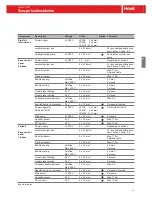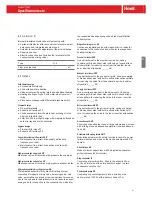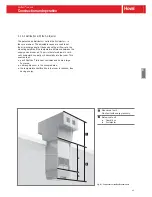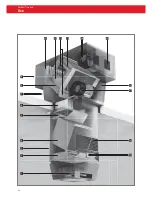
52
4 Design example
Note
The following design example relates to cooling mode. The design rating for heating mode can
be performed analogously to the design example above in Section B 'RoofVent
®
LHW.'
Design data
■
Required fresh air flow rate or air change rate
■
Hall geometry (length, width, height)
■
Design conditions
■
Desired room temperature (in the occupied area)
■
Extract air conditions
1)
■
Cooling load
■
Cooling medium
1)
The extract air temperature is generally higher than the temperature in the
occupied area. This is the result of unavoidable temperature stratifica-
tion in high spaces, but is reduced to a minimum with the Air-Injector. A
temperature gradient of only 0.2 K per metre hall height can therefore be
assumed.
Example
Fresh air flow rate ......................................75'000 m³/h
Hall geometry (L x W x H) .................... 72 x 60 x 10 m
Design conditions .................................... 32 °C / 40 %
Desired room temperature...................................26 °C
Extract air conditions ................................. 28 °C/50 %
Cooling load..................................................... 200 kW
Cooling medium.................................... LPCW 8/14 °C
Room temperature:..............................................26 °C
Temperature gradient: .................................. 10 · 0.2 K
Extract air temperature: ....................................= 28 °C
Required number of units n
req
Based on the air flow rate per unit (see Table C4), select a
trial unit size. (Depending on the results of further calcula-
tions, repeat the layout design for another unit size if neces-
sary.)
n
req
= V
req
/ V
U
V
req
= required fresh air flow rate in m³/h
V
U
= air flow rate for the selected unit size in m³/h
Approximate selection: Unit size LKW-10
n
req
= 75'000 / 8'400
n
req
= 8.93
Select 9 LKW-10s.
Actual fresh air flow rate V (in m³/h)
V
= n · V
U
n
= Selected number of units
V = 9 · 8'400
V = 75'600 m³/h
Necessary output to cover fabric cooling losses
(sensible cooling capacity) per unit Q
TG
(in kW)
Q
TG
= Q
Teff
/ n
Q
TG
= 200 / 9
Q
TG
≈ 22 kW
Selection of coil type
From Table C7, select the required coil type based on the
necessary output to cover fabric heat losses per unit.
Note
Note that the total cooling capacity Q
tot
must be used
for dimensioning of the chiller.
Select coil type C with 26 kW capacity to cover fabric
cooling losses at LPCW 8/14 °C and a fresh air tempera-
ture of 32 °C / 40 %.
RoofVent
®
LKW
Design example
Содержание RoofVent CON-9
Страница 2: ......
Страница 4: ...2...
Страница 6: ...4...
Страница 8: ...6...
Страница 12: ...10 RoofVent LHW Use...
Страница 40: ...38 RoofVent LKW Use...
Страница 68: ...66 RoofVent twin heat Use...
Страница 94: ...92 RoofVent twin cool Use...
Страница 122: ...120 RoofVent twin pump Use...
Страница 150: ...148...
Страница 154: ...152 RoofVent condens Use...
Страница 180: ...210 RoofVent LH Construction and operation...
Страница 208: ...238 RoofVent LK Use...
Страница 256: ...286...
Страница 268: ...298...
Страница 274: ...304...
Страница 279: ......








































